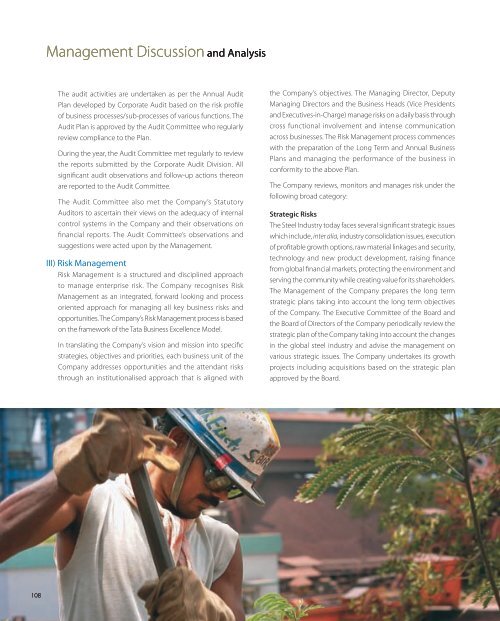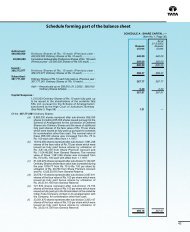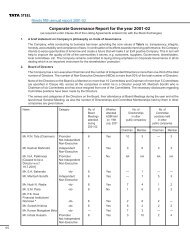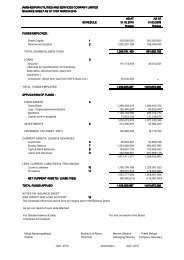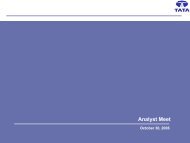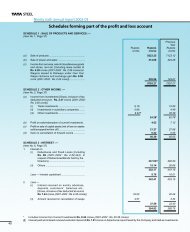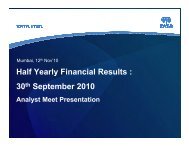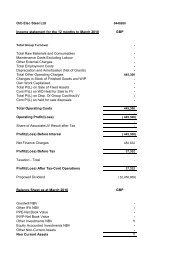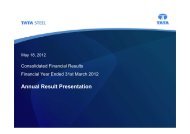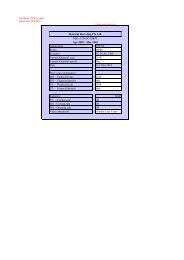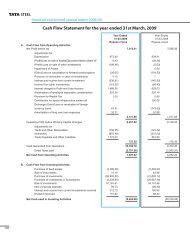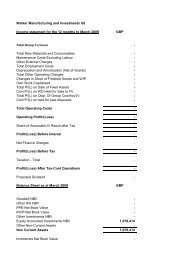100th Annual Report 2006-2007 - Tata Steel
100th Annual Report 2006-2007 - Tata Steel
100th Annual Report 2006-2007 - Tata Steel
Create successful ePaper yourself
Turn your PDF publications into a flip-book with our unique Google optimized e-Paper software.
Management Discussion and Analysis<br />
The audit activities are undertaken as per the <strong>Annual</strong> Audit<br />
Plan developed by Corporate Audit based on the risk profile<br />
of business processes/sub-processes of various functions. The<br />
Audit Plan is approved by the Audit Committee who regularly<br />
review compliance to the Plan.<br />
During the year, the Audit Committee met regularly to review<br />
the reports submitted by the Corporate Audit Division. All<br />
significant audit observations and follow-up actions thereon<br />
are reported to the Audit Committee.<br />
The Audit Committee also met the Company’s Statutory<br />
Auditors to ascertain their views on the adequacy of internal<br />
control systems in the Company and their observations on<br />
financial reports. The Audit Committee’s observations and<br />
suggestions were acted upon by the Management.<br />
III) Risk Management<br />
Risk Management is a structured and disciplined approach<br />
to manage enterprise risk. The Company recognises Risk<br />
Management as an integrated, forward looking and process<br />
oriented approach for managing all key business risks and<br />
opportunities. The Company’s Risk Management process is based<br />
on the framework of the <strong>Tata</strong> Business Excellence Model.<br />
In translating the Company’s vision and mission into specific<br />
strategies, objectives and priorities, each business unit of the<br />
Company addresses opportunities and the attendant risks<br />
through an institutionalised approach that is aligned with<br />
the Company’s objectives. The Managing Director, Deputy<br />
Managing Directors and the Business Heads (Vice Presidents<br />
and Executives-in-Charge) manage risks on a daily basis through<br />
cross functional involvement and intense communication<br />
across businesses. The Risk Management process commences<br />
with the preparation of the Long Term and <strong>Annual</strong> Business<br />
Plans and managing the performance of the business in<br />
conformity to the above Plan.<br />
The Company reviews, monitors and manages risk under the<br />
following broad category:<br />
Strategic Risks<br />
The <strong>Steel</strong> Industry today faces several significant strategic issues<br />
which include, inter alia, industry consolidation issues, execution<br />
of profitable growth options, raw material linkages and security,<br />
technology and new product development, raising finance<br />
from global financial markets, protecting the environment and<br />
serving the community while creating value for its shareholders.<br />
The Management of the Company prepares the long term<br />
strategic plans taking into account the long term objectives<br />
of the Company. The Executive Committee of the Board and<br />
the Board of Directors of the Company periodically review the<br />
strategic plan of the Company taking into account the changes<br />
in the global steel industry and advise the management on<br />
various strategic issues. The Company undertakes its growth<br />
projects including acquisitions based on the strategic plan<br />
approved by the Board.<br />
108


